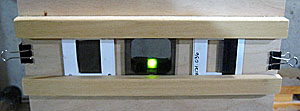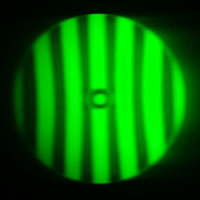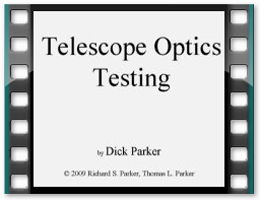|
||||
Testing OverviewUsing Two Tests The author's tester, similar to the 'Stellafane Tester',
has slots to hold 2"x2" test devices.
The author's tester, similar to the 'Stellafane Tester',
has slots to hold 2"x2" test devices.On the left is a home printed Ronchi Grating in a standard slide holder, center and illuminated is a glass Ronchi Grating, and on the right is a razor blade knife edge in a slide holder. This makes it easy to switch tests as desired. The philosophy of testing presented here is different from what is traditionally presented in mirror making books; we advocate using both the Ronchi Test and the Foucault Test. Most published information uses the Foucault Test exclusively, or if they do mention the Ronchi Test it is as an alternative and not part of the standard test regime. Why do we advocate using both, starting with the Ronchi and then moving on the Foucault? Because we feel testing is a frequent stumbling block for new mirror makers, and setting up your tester using only the Foucault Test is significantly harder than with the Ronchi Test. The Ronchi Test is easy to use to check for a spherical surface, and it does an excellent job of showing off edge problems. It is also much easier to set up and align a tester with the Ronchi Test than with the Foucault Test. The Tester Plans we present in this section make it easy to switch between both tests, allowing a Ronchi Grating or Knife Edge to be placed in front of the the light source and viewing area. Most other Knife Edge Testers can be easily adapted to the Ronchi Test if you can figure out how to place a Ronchi grating where the knife edge normally is, and in may cases the knife edge may not need to be removed. Testing FlowWe advocate using the Ronchi Test to setup and align your tester; it is easier to use because it is easier to find and use the multiple Ronchi bands on your mirror than the single knife edge shadow of the Foucault Test. We also are in favor of using the Ronchi Test when testing for a sphere (with the Foucault Test as a check) and when testing for edge problems, as they stand out so obviously with this test. In short, we like to use the Ronchi Test for getting to a good sphere, the base for figuring to a parabola. In all cases, we use the Ronchi Test qualitatively, with no measurements being made, just interpreting the Ronchi Bands with your eyes. Once we move on to figuring a parabola, we switch to the Foucault Test, and use it quantitatively. The ability to measure zones and compute (using free software) surface profiles and mirror quality make it the superior (and traditional) choice. A few mirror makers use the Ronchi Test for this task, but we find it much more difficult and error prone then the Foucault Test. Spherical Null Tests This Ronchigram, outside of the mirror's Radius of Curvature does not have straight, parallel bands, indicating the mirror is not spherical. The circle in the center is a collimation mark on the mirror. 'Null Test' in optician lingo means that you can precisely detect a spherical surface visually (qualitatively) with out further measurements or data reduction. In the Ronchi Test, a spherical surface has bands with perfectly straight and parallel edges; in the Foucault Tests, a spherical surface blinks - that is it turns from light to dark as the knife edge is cut in without any perceptible movement of shadows across the surface. Your ChoiceWhile we emphasize using the Ronchi Test for tester setup, testing for a sphere and checking the mirror edge for problems, we also present (in somewhat less detail) the traditional way of doing this with the Foucault Test. So if you can't or don't want to obtain a Ronchi Grating, or just want to stick with one test, you can do it the (more challenging?) traditional way using only the Foucault Test. Make Your OwnFollow this link to Print your own Ronchi Screen on overhead transparency film. Glass gratings are sharper, but this plastic gratings works well enough. Telescope Optics Testing VideoThis video provides a broad survey of the most commonly used tests by amateurs for spherical and parabolic surfaces, with emphasis on the the Foucault Knife-Edge Test and Ronchi Test. Topics covered include Knife Edge Test Basics, Null Testing for a Sphere, Seeing Surface Roughness, The Ronchi Test Basics, Ronchi Testing for a Sphere, Moving from a Sphere to an Ellipse to a Parabola, Spherical Aberration, Testing a Parabola, The Parabolic 'Doughnut', 'Doughnut' Shadows - Strong at f/4, soft at f/7, Tests that can Measure a Parabola, More Detail on the Foucault Test, More Detail on the Ronchi Test, Brief description of Wire and Caustic Tests, Null Tests for Parabolas, Mobsby Screen Test, Artificial Star Test, Dall & Ross Null Tests, Autocollimation Test, and the Star Test. Dick mentions in his video that he uses the Autocollimation Test with Ronchi Screen in his own workshop. At the Stellafane Mirror Class, we use this and the Ross Null Test, but principally we use the Autocollimation Test with a Knife Edge. The advantage of either version of the Autocollimation Test is that it is a null test for a Parabola (no processing of intermediate data required), with double the sensitivity of a single-pass test. Dick Parker is an accomplished mirror maker who is a member of The Springfield Telescope Makers, a Stellafane Mirror Class Instructor, and a member of the Astronomical Society of Greater Hartford. He runs the ASGH Mirror Making Workshop in central Connecticut, for which this video was originally produced. |
||||
|
Back to the ATM Index Page |
||||


